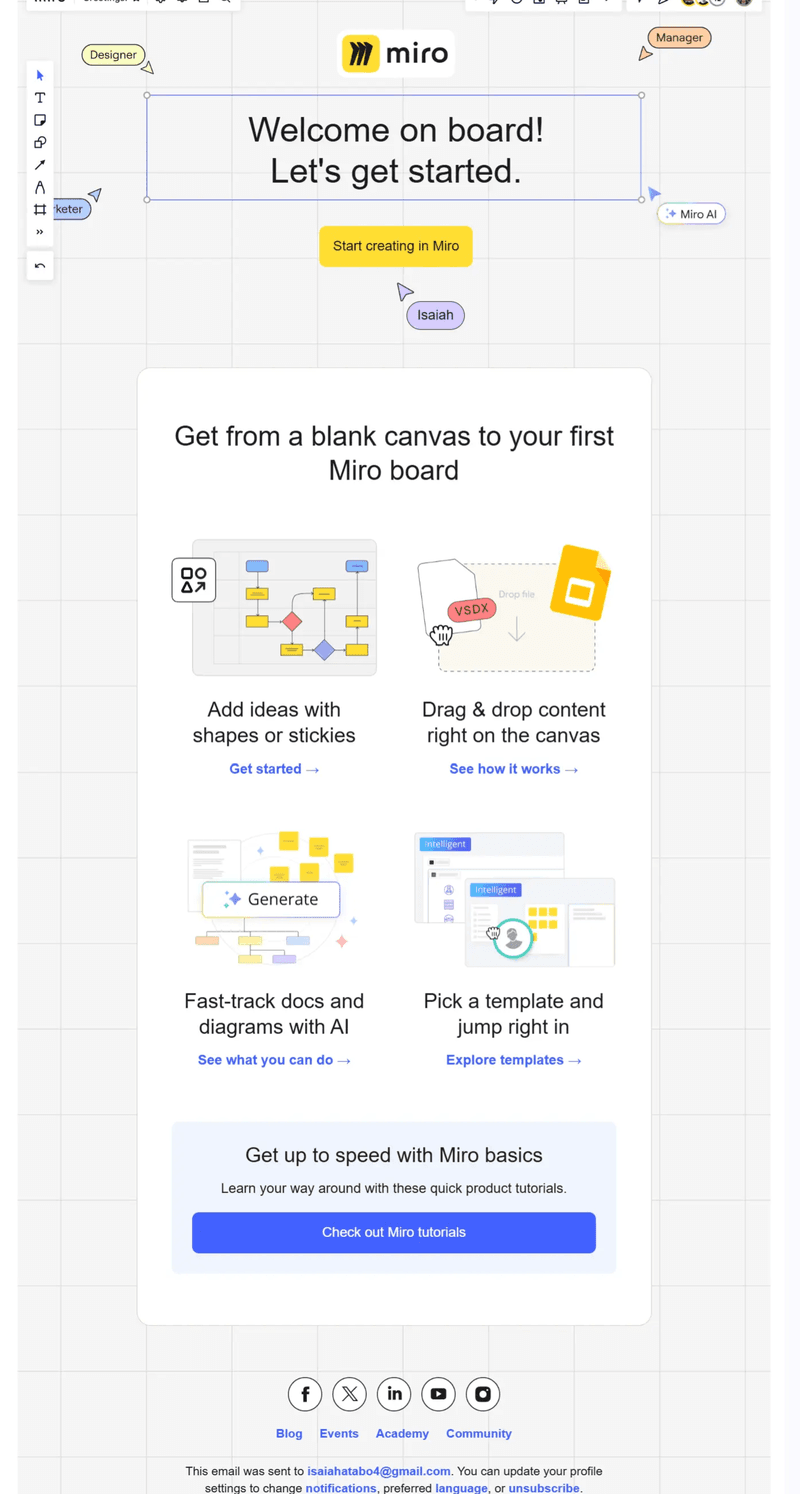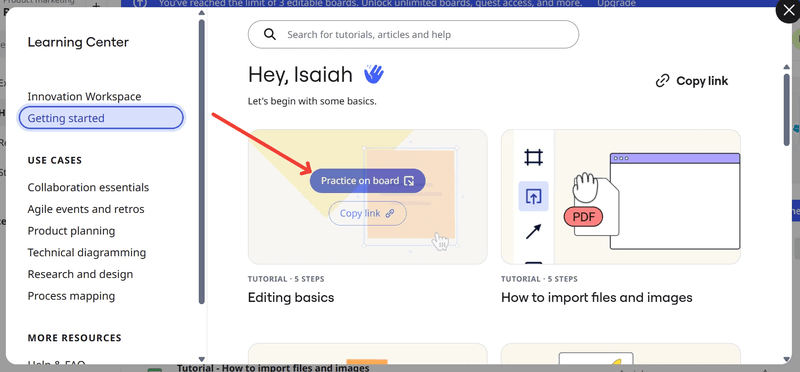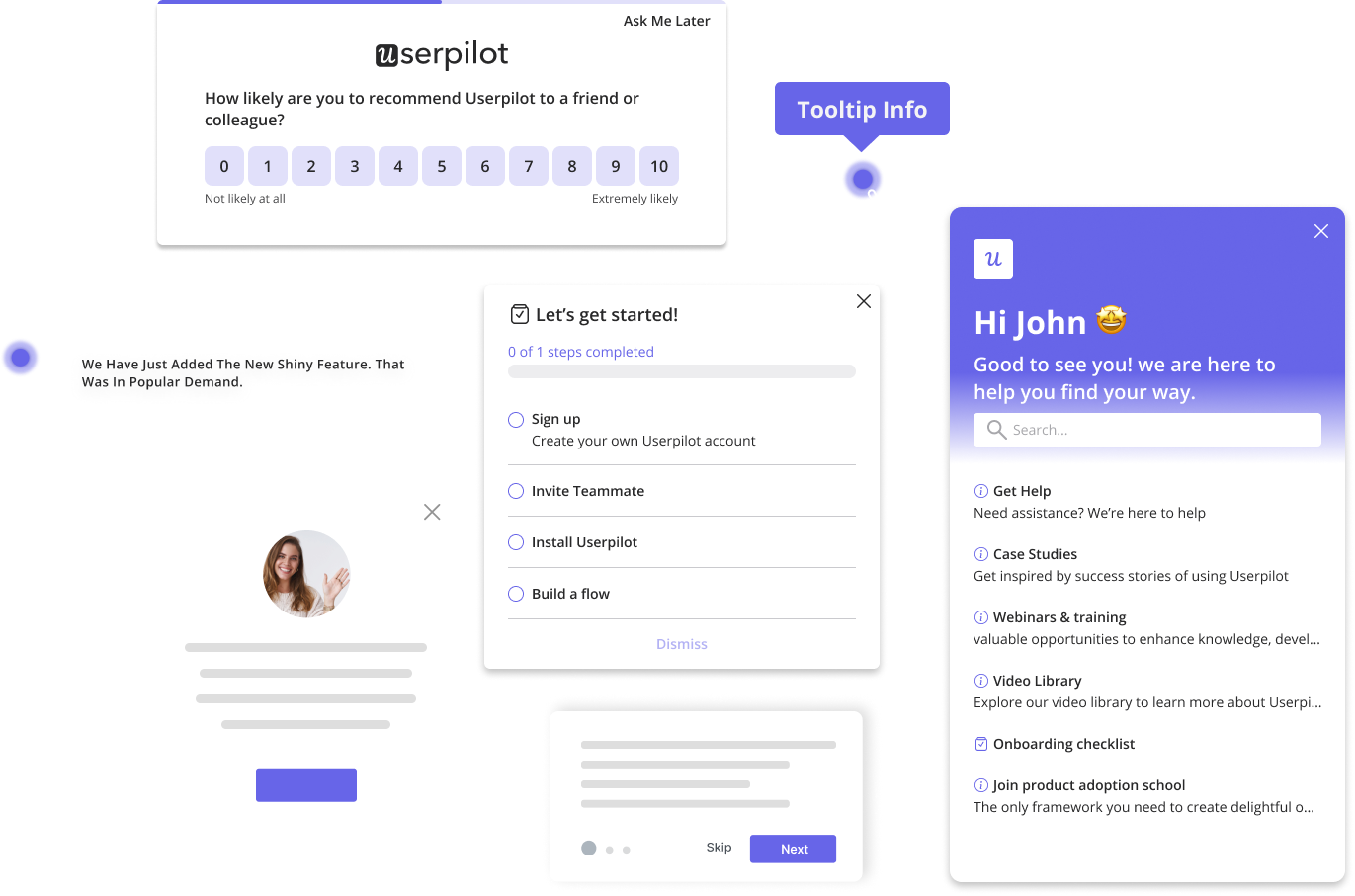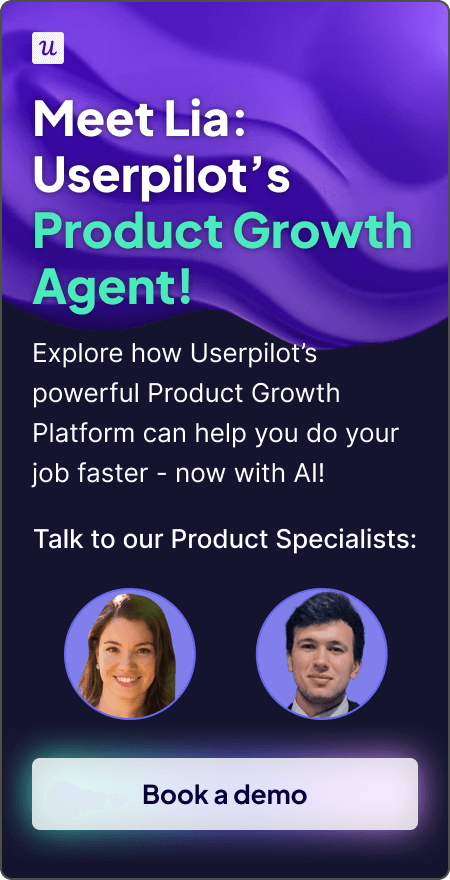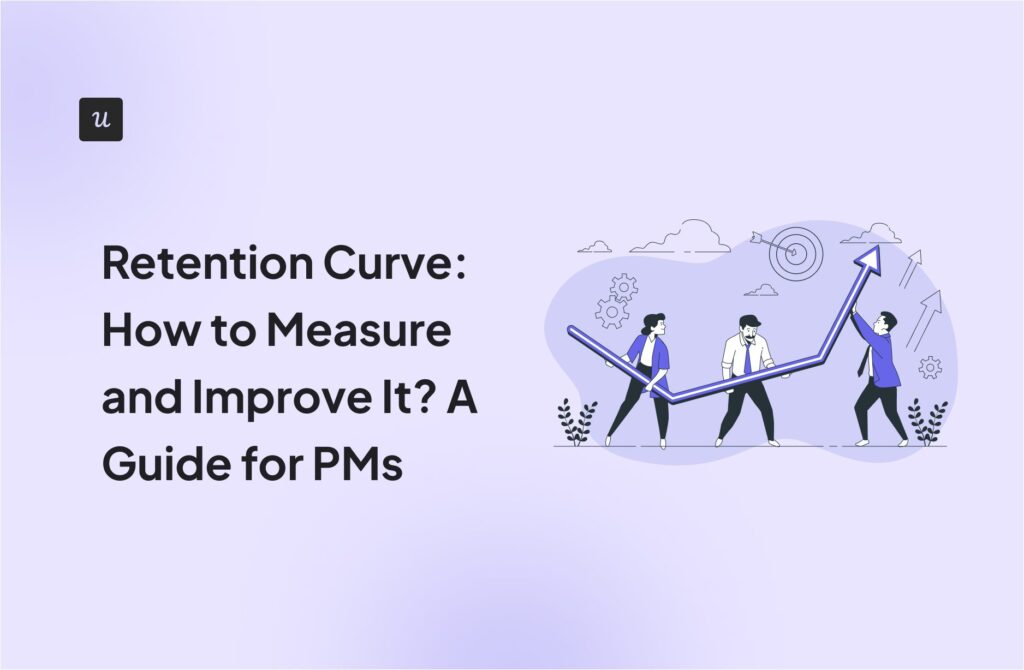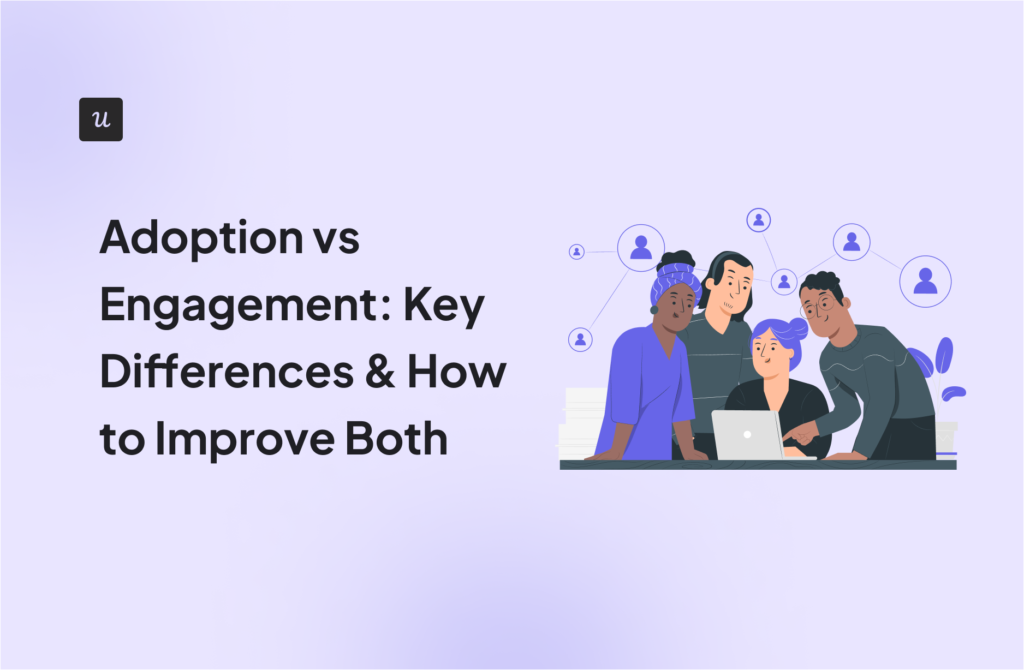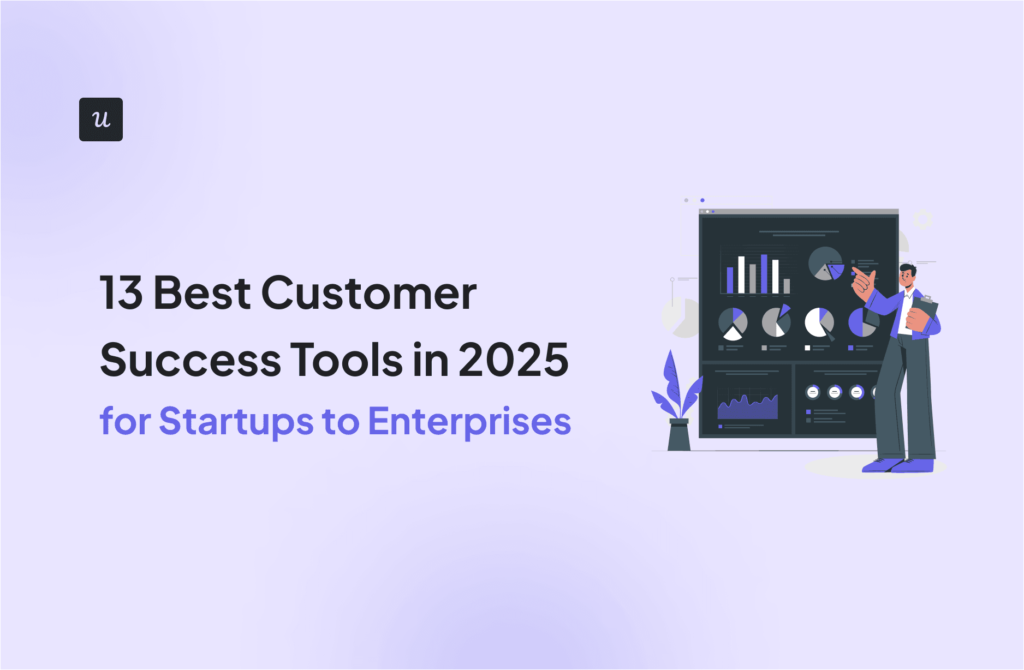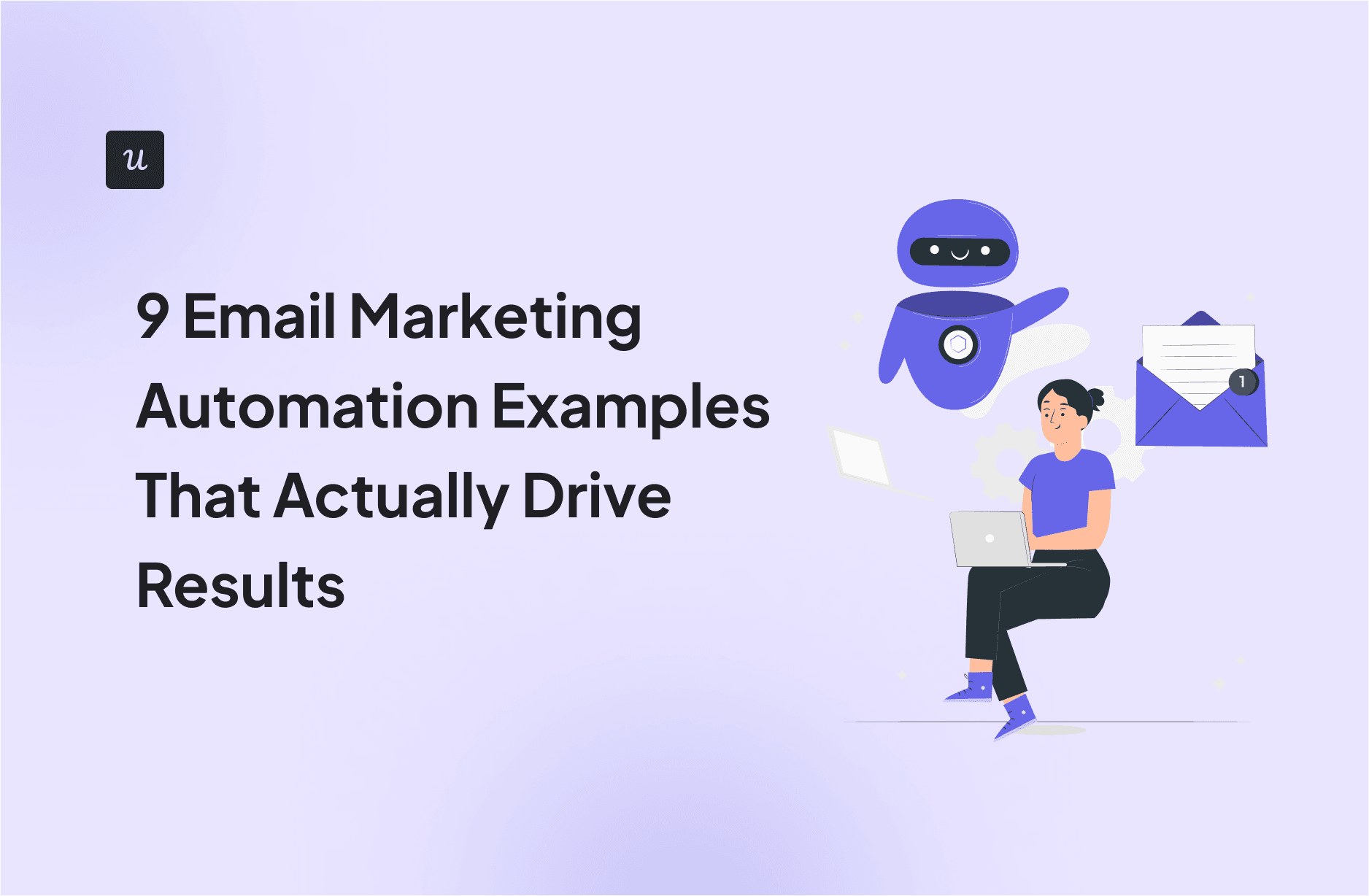
9 Email Marketing Automation Examples That Actually Drive Results
Try Userpilot Now
See Why 1,000+ Teams Choose Userpilot
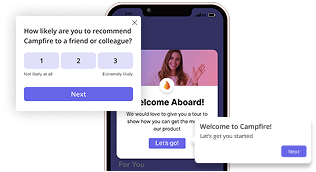
What is email automation in practice for SaaS?
Email automation is the deliberate practice of sending behavior-triggered email sequences that deliver the right message to the right person at the right time without manual effort.
People confuse email automation with drip campaigns, but they’re not the same. Drips are static and time-based, while true automation responds dynamically to user behavior, lifecycle stage, and context.
9 Email marketing automation examples by use case
In this section, I’ll break down nine effective email automation examples from successful SaaS companies. For each example, you’ll see:
- When to use it.
- What the flow looks like.
- Key triggers and segments.
- What to include in the email(s).
- A real-world example and what makes it work.
1. Welcome email series for new signups
A study by GetResponse found that welcome emails have the second-highest open and click-through rates, just behind webinar reminders. Why? Because new customers are excited about your product and eager to explore. With the right content and CTA, you can channel that excitement into long-term engagement.
Elements of an effective welcome series:
- Trigger: Signup.
- Flow: 3–5 emails spaced over 1–2 weeks.
- Content: Product intro, use cases, social proof, and light CTA.
What Miro gets right
I like Miro’s welcome email for several reasons. First, it’s on-brand: The design mirrors the app’s whiteboarding interface, so the user feels instantly familiar with the product environment.
The email opens with a clear welcome message and a CTA to start creating right away. From there, it presents several simple paths the user can take, such as adding stickies, exploring templates, or trying AI-powered diagrams.
Finally, it ends with a strong invitation to explore Miro’s tutorials. This last CTA is especially effective because it doesn’t send users to external support resources as many companies do. Instead, it directs them to Miro’s in-app learning center, where they can launch interactive walkthroughs and learn by doing.
You can easily recreate this type of welcome series in Userpilot by setting up email triggers based on user behavior, such as first login or first feature used.
To make the experience even smoother, you can schedule emails in advance and localize them for different regions so every new user feels welcomed at the right time, in the right language.
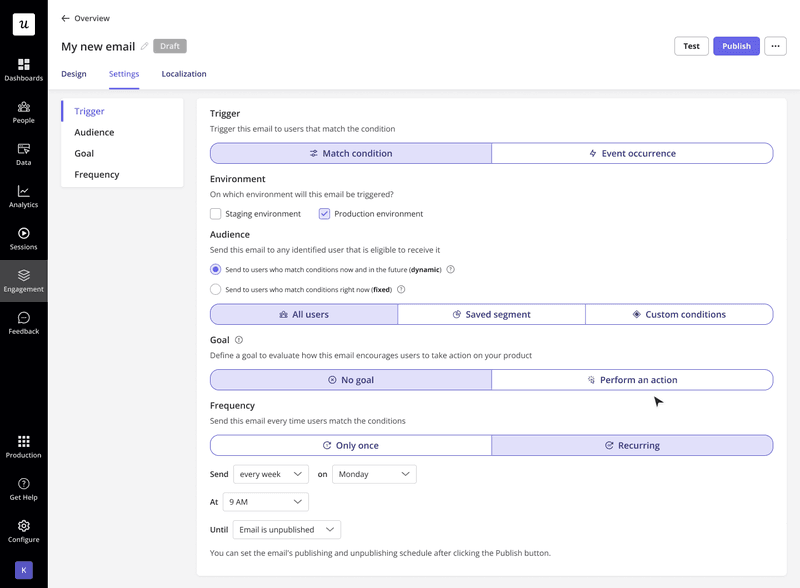
2. Onboarding/activation sequence
After welcoming customers, the next step is nudging them into your onboarding flow. Automated emails play a critical role here by showing key onboarding steps and triggering reminders or support resources for those who drop off halfway.
Elements of an onboarding sequence:
- Trigger: Account creation and product usage patterns.
- Flow: One well-placed email or a 3–5 email sequence, depending on your onboarding strategy.
- Content: Feature walkthroughs, case studies, how-to guides, and quick tips.
What Fullstory gets right
FullStory’s email zeroes in on the single most important next step for its new users: installing the platform’s recording snippet.
The headline is short and direct, while the supporting copy highlights the immediate value users will unlock once setup is complete.
To encourage action, the email closes with an unmistakable CTA button (“Copy your snippet”) that guides users straight to activation.
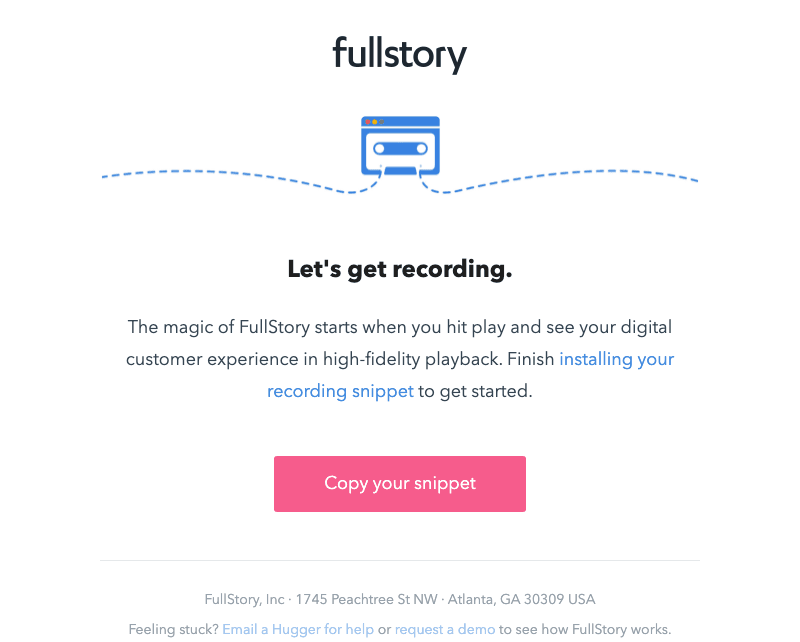
Want to create something similar? With Userpilot, you can build email sequences, set conversion goals, and determine the frequency of each email.
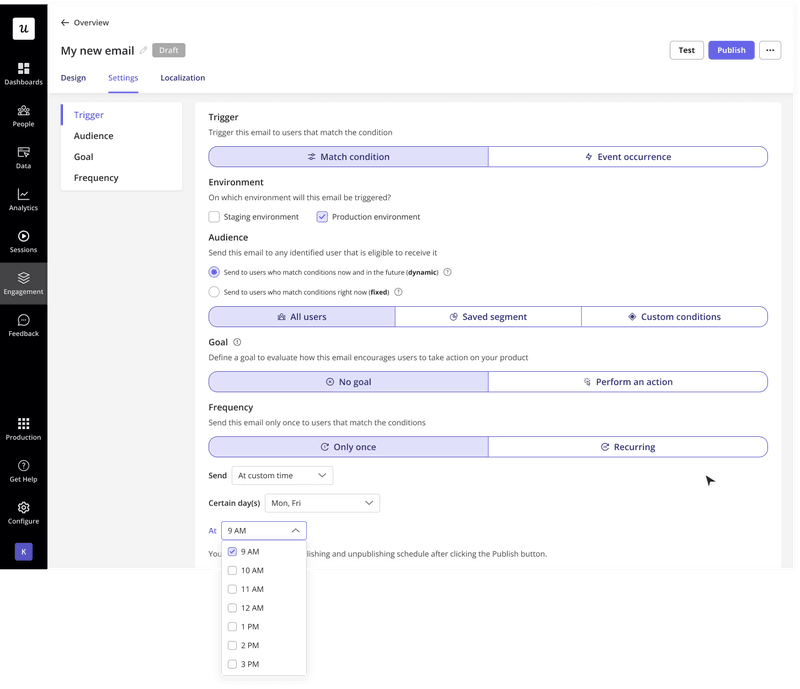
3. Cart abandonment or checkout recovery
Cart abandonment emails are more common with e-commerce automation, but I’ve found the idea equally useful in SaaS.
For example, I regularly see cases where users start exploring a pricing plan, initiate checkout, or begin adding teammates, but never complete the process. Recovery emails triggered in these situations can remind customers of the value they’re leaving behind and encourage them to finish the process.
Elements of effective recovery flows:
- Trigger: Account setup or checkout started but not completed.
- Flow: One to three emails spaced over a few days.
- Content: Urgency messaging, benefits recap, objection handling, and social proof/testimonials.
What Headspace gets right
The email below is a classic example of how to craft an effective recovery email. Instead of shaming the user for not finishing checkout, Headspace acknowledges distractions with a playful note (“We all get distracted sometimes – squirrel!”). This humor softens the reminder and makes the brand feel more relatable.
The design is equally effective. A bold “Continue to Checkout” button gives users one clear path back to conversion, while secondary links provide more context about Headspace Plus.
To lower friction even further, the email includes support options like an FAQ link and a direct support email, signaling that help is available if checkout issues were the barrier. Together, these elements combine urgency with empathy and make the nudge both persuasive and user-friendly.
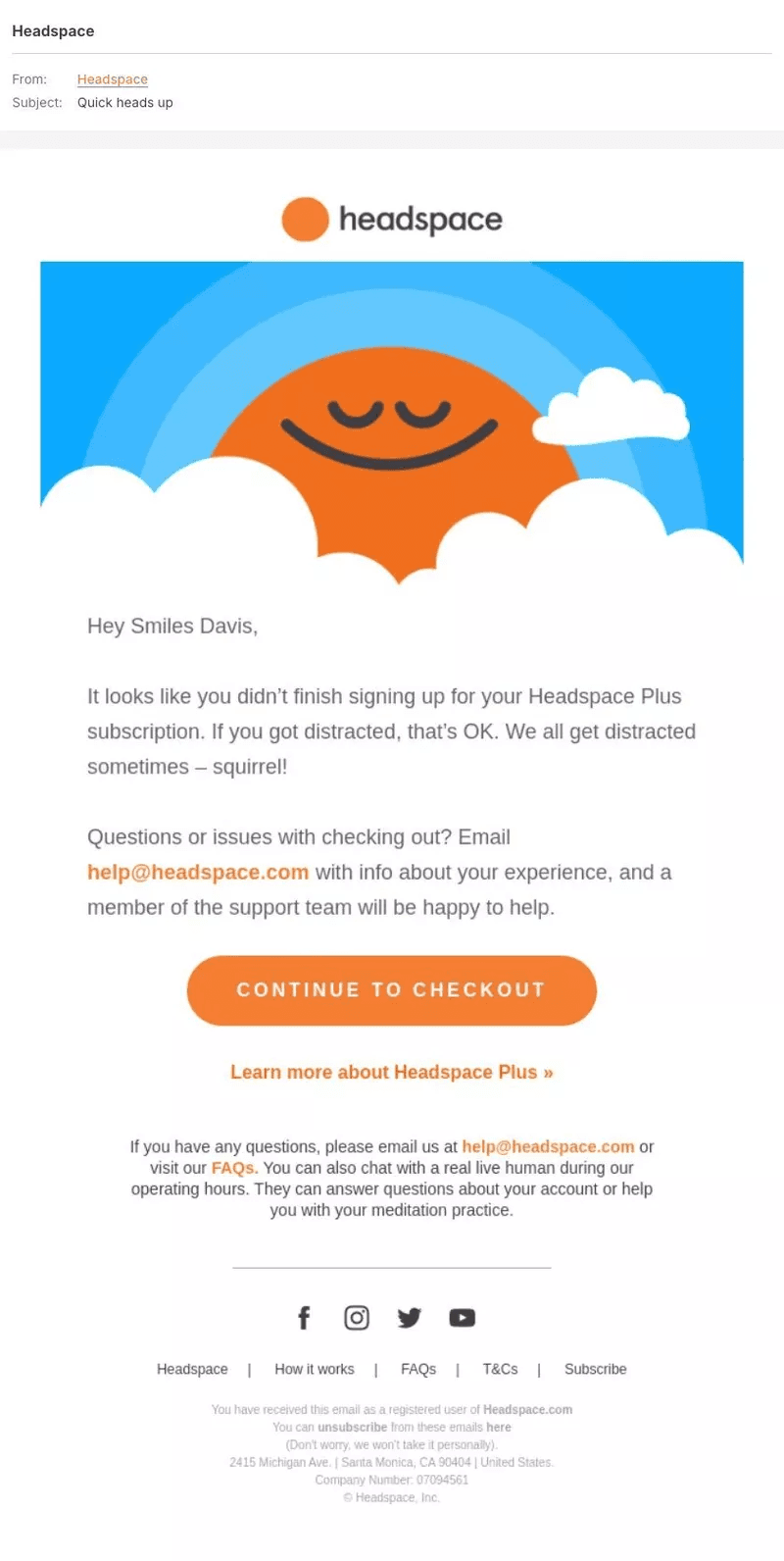
You can build similar recovery sequences in Userpilot by using inactivity or incomplete in-app actions as triggers.
For example, if a user starts setting up a workflow or invites teammates but doesn’t finish the process, you can set up a flow that automatically sends them a targeted follow-up. Pairing these emails with in-app modals or tooltips creates a cohesive customer experience that increases overall engagement..
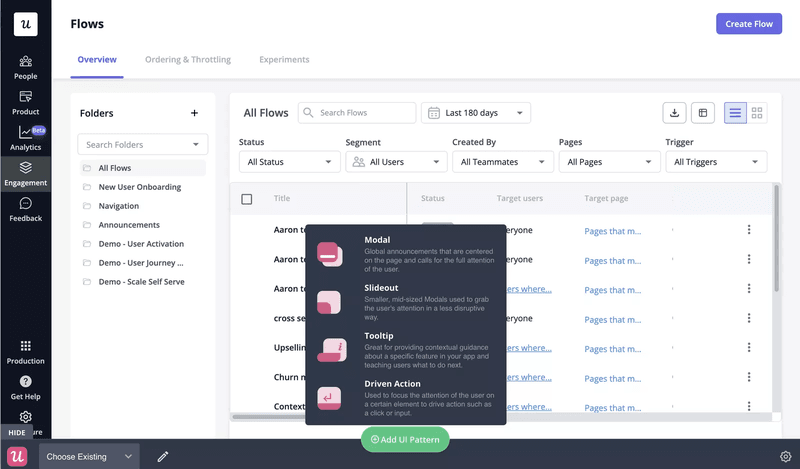
4. Re-engagement emails or “win back” email campaigns
Gainsights reports that more than half of customers churn without stating their reasons for leaving. But the good news is that most of these users exhibit warning signs such as extended inactivity, a drop in feature usage, or disengagement from regular workflows.
Once your analytics tool flags any of these signals, you can automatically launch re-engagement emails to catch the user’s attention and bring them back.
Elements of effective re-engagement emails:
- Trigger: No logins or activity for X days.
- Flow: One-off reminder or a short sequence (2–3 emails).
- Content: “We miss you” messages, recent product updates, incentives, and even messages about any loyalty programs you may have.
What Asana gets right
Asana’s email is intentionally simple to lower users’ resistance to re-engagement.
It uses animation for visual effect and directly tells the user that the platform has become 2x faster than before. The email then closes with a single, prominent “Try it now” CTA to prompt immediate action.
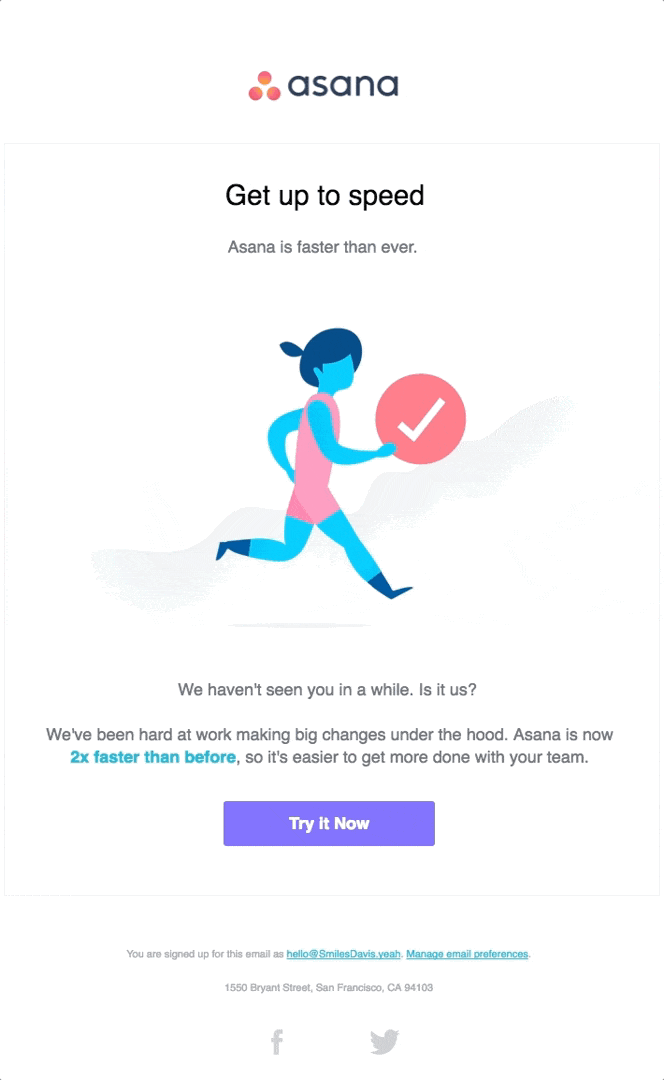
What if you haven’t shipped any big product updates since the last time a user was inactive? In that case, other messaging angles I’ve seen work well for SaaS companies include:
- Highlighting recent customer success stories to show ongoing value.
- Resurfacing underused features that inactive users may have missed.
- Offering incentives, such as limited-time discounts or extended trials, to reignite interest.
5. Post-purchase or post-trial nurture
Just because someone becomes a paying customer doesn’t mean your email marketing efforts should end. This matters even more in SaaS, where the average CAC payback period is between 20 and 30 months. With high upfront costs and months needed to recover CAC, it’s wasteful to let existing users slip away.
They’ve already been convinced of your product’s value, so your goal is to strengthen customer relationships by ensuring they have a delightful product experience and receive occasional emails that nurture them into becoming loyal.
Elements of effective post-purchase or post-trial nurture emails:
- Trigger: Purchase completed or trial ends.
- Flow: Short sequence delivered over the first 30–60 days.
- Content: Tips to get more value, referral invitations, usage milestones, and celebrations.
What Grammarly gets right
Grammarly delivers personalized weekly writing reports that highlight a user’s productivity, accuracy, and vocabulary growth. Together, these elements demonstrate immediate product value and encourage users to keep returning to the app.
The email includes writing streaks, mastery benchmarks, and even the unique words a user used that week. These small touches gamify the customer experience and make progress feel tangible.

Think of unique ways to keep your product top of mind in a user’s inbox. Ideally, you want something that can be automated, like Grammarly’s Weekly Insights. However, if that isn’t feasible, here are three alternatives:
- Weekly newsletters focused on customer education.
- Customer spotlight emails that showcase success stories.
- Feature deep-dives that highlight one valuable but underused feature.
For example, Userpilot publishes a monthly newsletter called The PITT that brings together product updates, industry insights, and actionable strategies for product marketers.
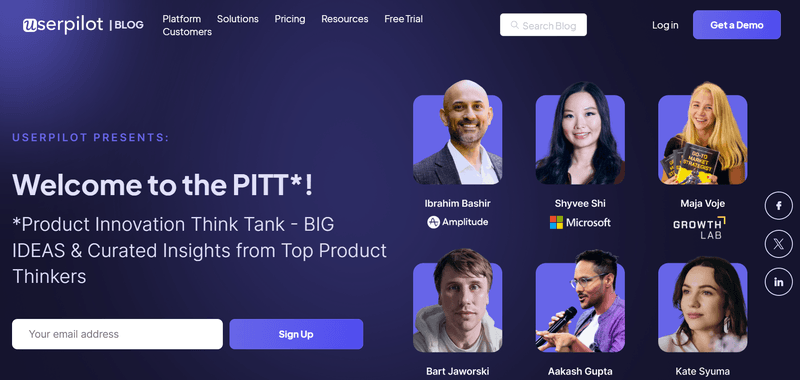
6. Product usage milestone celebration
Milestone emails give users reasons to feel good about their progress.
They’re also great opportunities to prompt users to take the next step in their journey. For example, after successful onboarding, you can send a congratulatory email with links to advanced features and explain why they matter to the user.
Elements of effective milestone celebration emails:
- Trigger: Reaching a specific product milestone.
- Flow: Typically, a one-off congratulatory email at specific points in the customer journey.
- Content: Celebratory tone, personalized achievement highlight, tips to go deeper, and an optional upgrade CTA.
What Canva gets right
Canva celebrates user milestones with a bright trophy graphic that instantly communicates accomplishment. Showing past achievements (like 5 designs) alongside a future goal (20 designs) is a subtle but effective way to encourage continuous engagement.

The built-in sharing prompt also contributes to a network effect. Users proudly share their milestones on social media as bragging rights, which in turn inspires new audiences and motivates other Canva users to unlock their own trophies.
Here’s an example of Jasmine excitedly sharing her 50-design milestone:

7. Review request emails
Gartner’s 2025 software buying trends report shows that 90% of customers make buying decisions based on some form of social proof. At the top of the list are customer reviews, expert recommendations, and Internet Search engines. This means SaaS companies can’t afford to be passive about gathering feedback, and that’s where automated emails come in.
Once set up, your automated email flows can help you gather feedback at scale during key lifecycle stages like onboarding completion, account renewals, or even post-support interactions.
Elements of effective review request emails:
- Trigger: X days after signup, after a milestone, or after ticket resolution.
- Flow: One to two simple requests sent at the right moment.
- Content: Short message, frictionless form or direct link, and clear instructions on where to leave a review.
What Userpilot gets right
Userpilot provides a customizable email template to help you quickly gather customer reviews.
You can set logic conditions to make the requests automatic and recurring. For example, imagine targeting users on a high-tier plan who renew their accounts at least five times. Once set, future users automatically receive a review request email as soon as they meet that criteria.
Userpilot also lets you schedule emails to automatically resend weeks or months later to qualified users who didn’t open the initial request. This feature helps you maximize responses without overwhelming your audience.
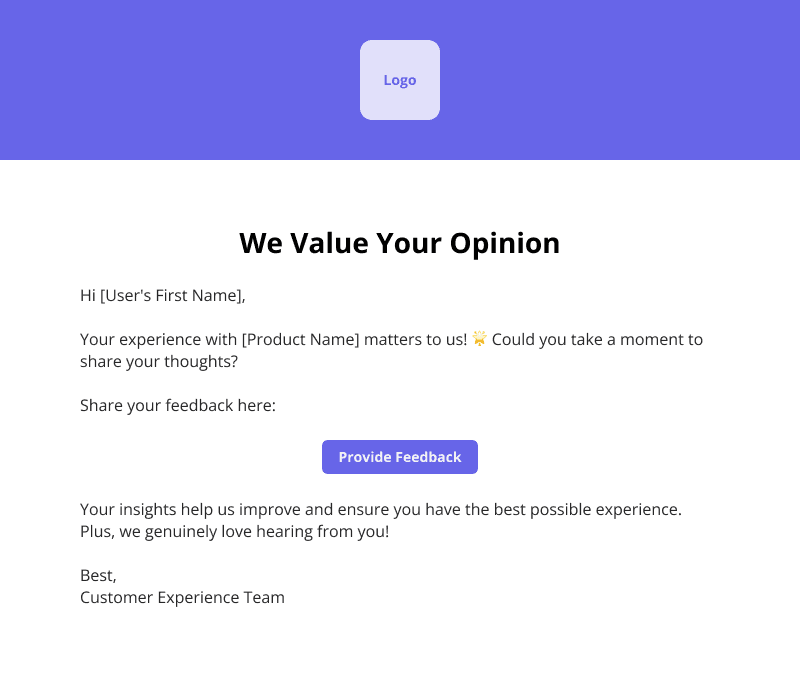
8. Upgrade/expansion sequence
According to the 2025 B2B SaaS Performance Metrics Benchmarks by Benchmarkit, expansion ARR now represents 40%–50% of total new ARR for SaaS companies.
It’s not difficult to see why. As I mentioned earlier, existing customers are the easiest to sell to because they already trust your product.
But you need to be strategic: rather than waiting for customers to reach out, use in-app analytics to monitor their behaviors and trigger automatic upgrade or cross-sell emails when they hit usage thresholds, bump against plan limits, or show strong intent to expand into new features.
Elements of effective upgrade/expansion emails:
- Trigger: Hitting usage thresholds or nearing plan limits.
- Flow: A short sequence paired with in-app nudges.
- Content: Contextual subject line, feature teasers that encourage customers to unlock more value, benefit reminders, and urgency-driven CTAs.
What Zapier gets right
Zapier’s upgrade email starts by congratulating the user on automating 229 tasks, immediately reinforcing the value they’ve already received from the product. From there, the email clearly explains what will be lost if they don’t upgrade.
This balance of encouragement and limitation makes the upgrade feel like the next natural step for an engaged user. Zapier makes the decision straightforward by ending with a prominent green CTA to “Select a Premium Plan.”
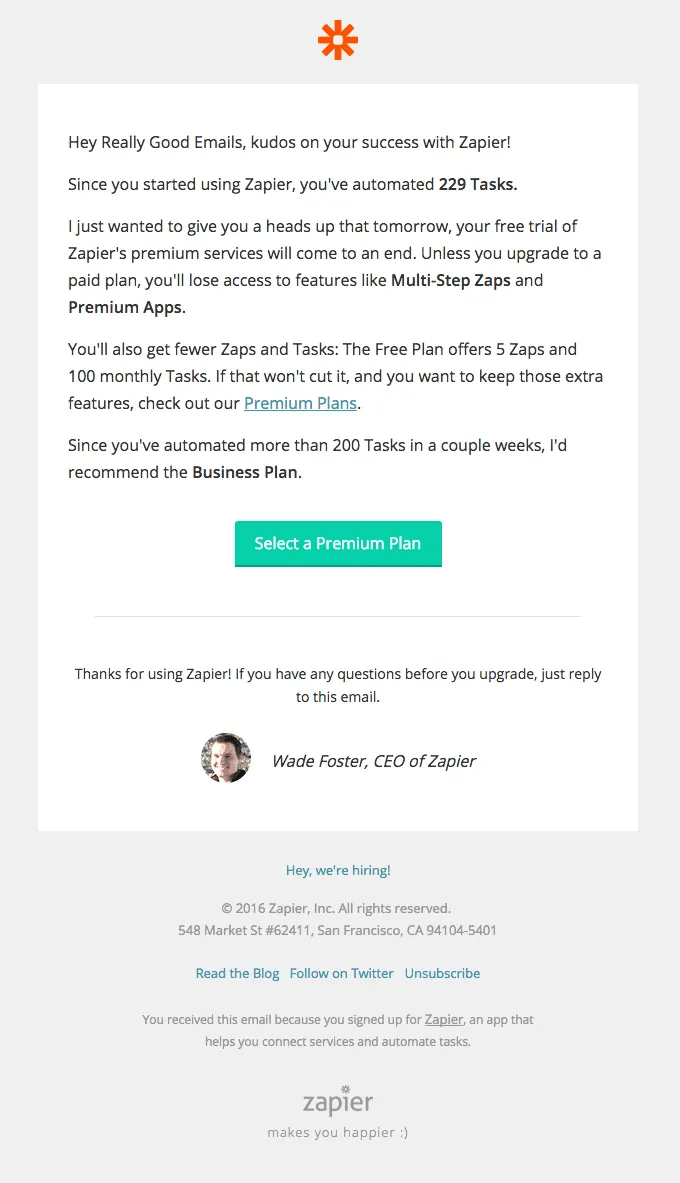
Userpilot provides a fully customizable upsell email template to help you save time and stay consistent with your brand. You can set triggers based on usage thresholds or nearing plan limits, then automatically deliver upgrade nudges at the right moment.
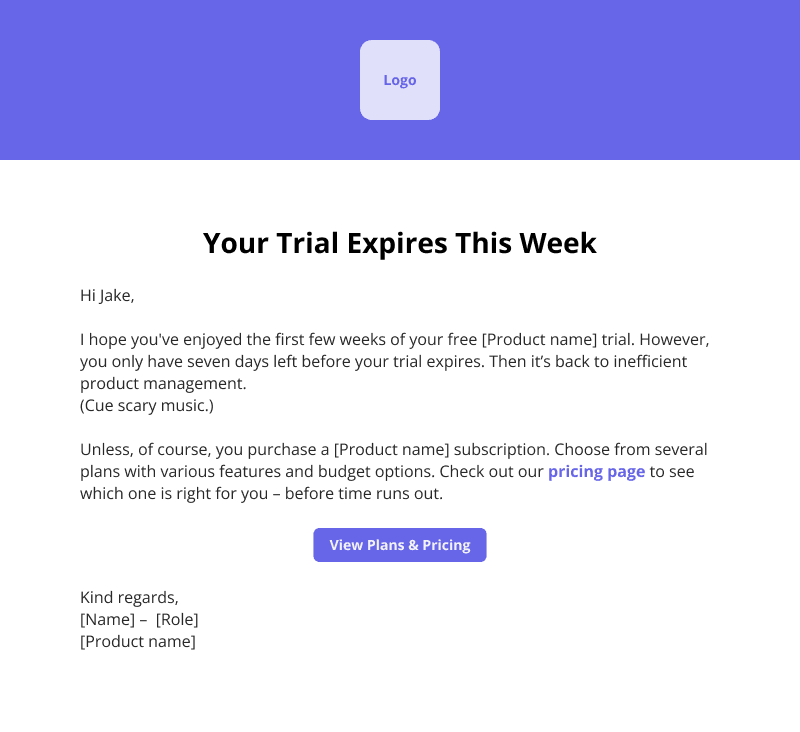
9. Event-based emails
Event-based emails help you deliver relevant information that adds value and prompts immediate action. Common examples include product launches, feature releases, webinars, and changelog updates.
Elements of effective event-based emails:
- Trigger: Registration, release date, or product update
- Flow: Single email or a short reminder sequence.
- Content: Key details, value proposition, and a clear CTA.
What HelpScout gets right
HelpScout’s email is effective because it provides value upfront. Instead of a vague “don’t miss this event,” the email tells users exactly what the session is about, who they’ll hear from, and why it matters.
This level of clarity helps set expectations and convince users to join if they’re interested. Mentioning guest companies like Zapier and Copy.ai also adds credibility and social proof that subtly communicates, “Your time here will be well spent.”
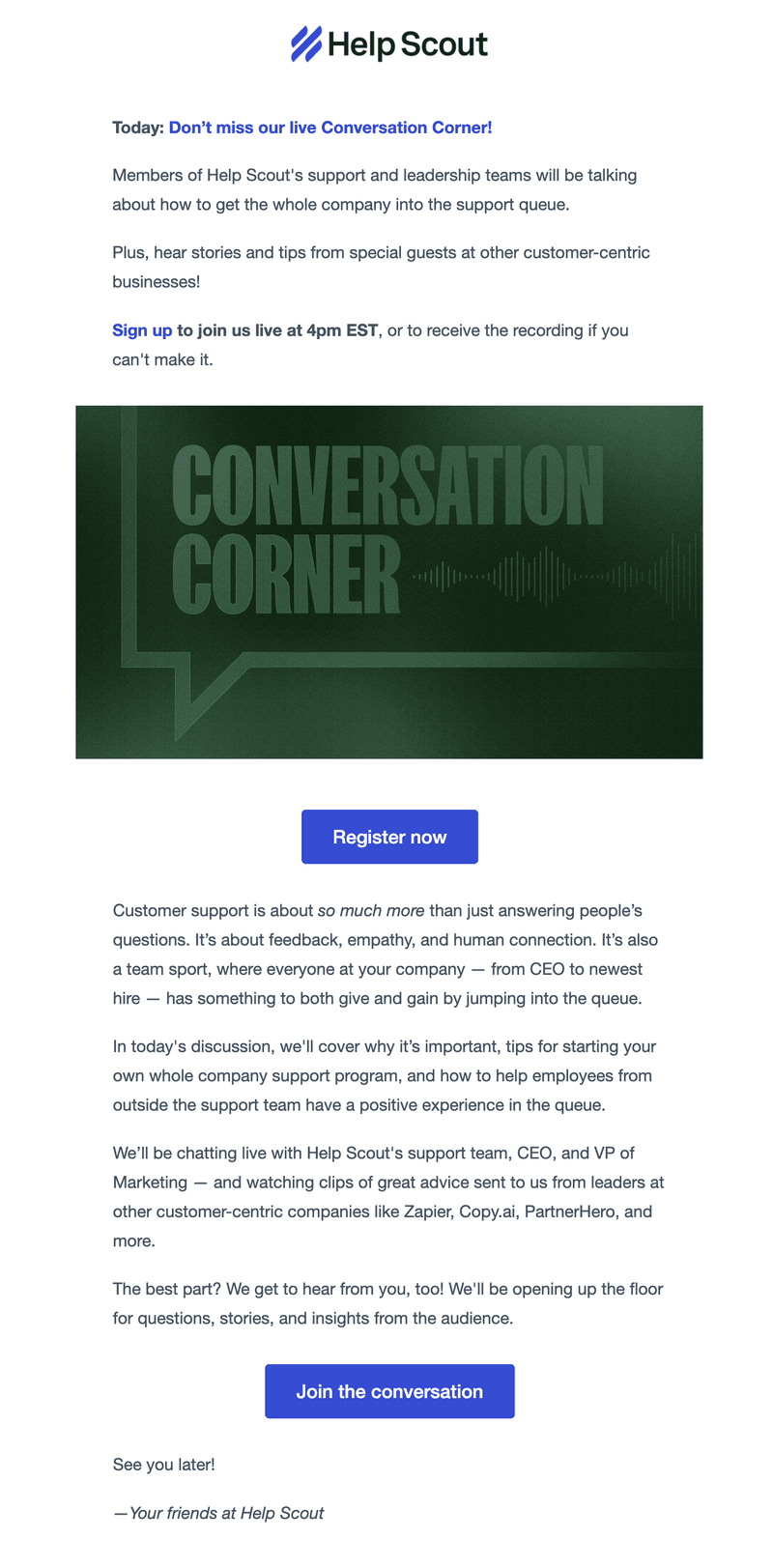
Whether you’re announcing a new feature or inviting users to a live training, HelpScout’s style offers a blueprint for boosting participation. Start the email with clear context and benefits, then close with a bold, unmistakable CTA that guides the user to act.
My pro tips for building smarter email automations
After working with countless SaaS email campaigns, I’ve noticed the difference between average automation and the kind that truly drives results comes down to execution. The following tips will help you refine your workflows, avoid common mistakes, and maximize the impact of your overall marketing strategy.
1. Don’t automate everything—only what benefits from timing + behavior
Good automation happens when there’s a clear trigger-action-reward pattern. If there’s no behavioral context or urgency, you risk sending irrelevant emails that feel robotic or even pushy.
For example, imagine blasting a generic upgrade offer to all free users every week, regardless of where they are in their journey. Most recipients will tune it out, and some might even unsubscribe because the message doesn’t apply to them.
A smarter approach is to use an analytics tool like Userpilot to track customer behavior and set up flows that automatically trigger based on in-app actions. Let’s return to the goal of converting free users. Instead of sending generic emails, you could wait for users to hit a usage limit on their free plan and immediately fire an in-app modal that explains the restriction and invites them to upgrade.
If they don’t upgrade right away, follow up within a few hours or a day with an email that dives deeper into the benefits of upgrading and ends with a clear CTA.
2. Map automations to customer lifecycle goals
Every automation should have a clear job to do, and that job needs to align with the customer’s journey, lifecycle goals, and ultimately how you manage customer relationships at scale.
For example, someone early in their journey might not respond well to upgrade prompts because they’re still exploring your tool and probably even comparing it with competitors.
What will appeal most to them at that stage is a great onboarding experience and resources that help them become familiar with your software’s key functionalities.
Here are the four major lifecycle stages and the type of content you should be aiming for:
- Acquisition: Welcome and warm-up flows that introduce value.
- Activation: Onboarding nudges that drive “Aha!” moments.
- Retention: Milestone celebrations, value reminders, and re-engagement flows designed to deepen customer loyalty.
- Expansion: Upgrade nudges and usage-based CTAs that encourage account growth.
3. Test subject lines, timing, and sequencing
I’m a firm believer in continuous testing and optimization, because that’s the only way to discover what actually resonates with your audience. What works today may underperform tomorrow, and assumptions alone are rarely reliable.
Start with A/B tests on subject lines to see which angles drive higher open rates. Then, experiment with send times and adjust the delays between emails based on real engagement data.
Userpilot lets you do all of this without writing a single line of code. The email analytics dashboard makes it easy to monitor email opens, click-through rates, bounce rates, and unsubscribes at a glance.
Since Userpilot also tracks in-app behavior, you can follow the funnel to see how many users who clicked your email CTAs went on to complete the desired in-app action. This kind of insight makes your experiments practical and helps you turn results into measurable business growth.
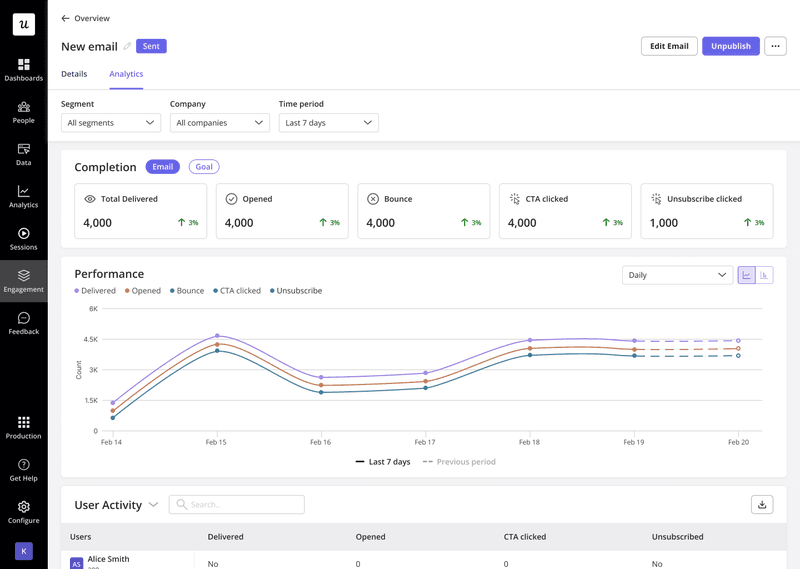
4. Integrate product data to send personalized messages
I’ve seen companies assume what users should be doing at a given stage and then send automated emails they believe are contextual. That approach is usually hit or miss.
A more effective strategy is to connect email automation directly to live product data and build flows that trigger when users take, or abandon, specific actions
For example, instead of sending a “Here’s what you can do with our product” email, you might:
- Trigger a reminder when a user invites teammates, but those teammates never accept the invitation.
- Send an achievement email when someone creates their first project, with tips on scaling it further.
- Deliver a progress recap if a user hasn’t logged in for two weeks but recently crossed a key milestone, encouraging them to pick up where they left off.
Bonus: Some SaaS companies experiment with birthday and anniversary emails as an additional way to personalize the customer experience. It’s a great strategy to consider if it aligns with your brand’s personality.
Your automation is only as good as the data behind it
If there’s one key takeaway from all the email automation examples we’ve considered, it’s this: the best automated messaging doesn’t feel automated. From the subject line to the final CTA, every element feels personal, relevant, and perfectly timed.
To do so, you need a way to track real-time customer data and connect it directly to your email flows. That’s where Userpilot comes in. Our platform lets you combine in-app behavior tracking with customizable email templates, so you can deliver messages that are both timely and contextual.
Ready to see it in action? Book a demo to discuss with our team.
FAQ
What is the difference between email marketing and marketing automation?
Email marketing is the broad practice of sending campaigns to your audience.
Marketing automation takes it further by using triggers, data, and workflows to create relevant content and deliver the right message at the right time.
What is the email marketing tool for automation?
There are many options, depending on your budget and goals. Popular examples include Mailchimp, HubSpot, and ActiveCampaign.
If you’re a SaaS company, the best email automation tool is an all-in-one platform like Userpilot that combines product analytics with email marketing automation to help you reduce costs and avoid data silos.
Can you use AI to automate emails?
Yes. AI can optimize subject lines, predict the best send times, generate personalized content variations, and help with other aspects of email marketing automation.
However, AI works best when paired with product data, because context is what makes users open and act on automated emails.

